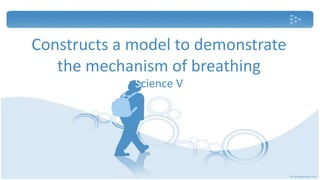
1st science 13 constructs a model to demonstrate the mechanism of breathing
- 1. Constructs a model to demonstrate the mechanism of breathing Science V
- 2. Review Identify the parts of the Respiratory System It is lined with fine hairs called cilia which filter air before it reaches the lungs. It keeps the windpipe open.
- 3. Review Identify the parts of the Respiratory System TRACHEA It is lined with fine hairs called cilia which filter air before it reaches the lungs. It keeps the windpipe open.
- 4. Review Identify the parts of the Respiratory System It warms, moistens, and filters air as it is inhaled.
- 5. Review Identify the parts of the Respiratory System NASAL CAVITY It warms, moistens, and filters air as it is inhaled.
- 6. Review Identify the parts of the Respiratory System The functional respiratory units in the lung where gases are exchanged.
- 7. Review Identify the parts of the Respiratory System ALVEOLI The functional respiratory units in the lung where gases are exchanged.
- 8. Review Identify the parts of the Respiratory System Passage way for air that leads to trachea.
- 9. Review Identify the parts of the Respiratory System PHARYNX Passage way for air that leads to trachea.
- 10. Review Identify the parts of the Respiratory System A large sheet of skeletal muscle below the ribs. It controls the process of breathing and moves up and down during the breathing process.
- 11. Review Identify the parts of the Respiratory System DIAPHRAGM A large sheet of skeletal muscle below the ribs. It controls the process of breathing and moves up and down during the breathing process.
- 12. Review Identify the parts of the Respiratory System Two branches at the end of the trachea, each lead to a lung.
- 13. Review Identify the parts of the Respiratory System BRONCHI Two branches at the end of the trachea, each lead to a lung.
- 14. Review Identify the parts of the Respiratory System The voice box where the vocal chords are located.
- 15. Review Identify the parts of the Respiratory System LARYNX The voice box where the vocal chords are located.
- 16. Review Identify the parts of the Respiratory System A network of smaller branches leading from the bronchi into the lung tissue and ultimately to the air sacs.
- 17. Review Identify the parts of the Respiratory System BRONCHIOLES A network of smaller branches leading from the bronchi into the lung tissue and ultimately to the air sacs.
- 18. Review Identify the parts of the Respiratory System It controls opening to the larynx.
- 19. Review Identify the parts of the Respiratory System EPIGLOTTIS It controls opening to the larynx.
- 20. Checking of Assignment Did you bring the following? • an empty stick-o or 1.5 soft drink bottle • a Y-shaped glass tube • rubber bands and clay • two small and one big balloons • pair of scissors
- 21. Motivation Close your lips tightly and pinch your nose so that no air can enter the lungs. Then breathe in and out. Next, feel the lower part of your ribs. Can you feel diaphragm going up and down?You will find out how air is forced in and out of your lungs.
- 22. Presentation Watch the video clip: MECHANISM OF BREATHING Part 01 by 7activestudio
- 23. Motivation Perform Activity Mechanics of Breathing as shown in the diagram
- 24. Presentation Problem: What happens to the lungs as we breathe? What You Need: • rubber bands and clay • two small and one big balloons • pair of scissorsan empty stick-o or 1.5 soft drink bottle • a Y-shaped glass tube
- 25. Diagram
- 26. What To Do: 1. Assemble the materials as shown in the diagram. 2. Pull the rubber sheet downward. Observe what happens to the balloons inside. 3. Observe what happens when the rubber sheet is released.
- 27. What have you found out? 1. What part of the model represent the chest cavity? 2. What part of the model represents the lungs? How about the diaphragm? 3. What happened when the rubber sheet was pulled downward? 4. What happened when the rubber sheet was released?
- 28. Conclusion: Through your chest-lung model, demonstrate the mechanics of breathing.
- 29. Concept Formation Answer the questions in the activity. 1. What part of the model represent the chest cavity? 2. What part of the model represents the lungs? How about the diaphragm? 3. What happened when the rubber sheet was pulled downward? 4. What happened when the rubber sheet was released?
- 30. Evaluation Explain the mechanism of breathing using the chest-lung model
- 31. Assignment Will the size of the chest cavity affects the volume of the air drawn? Bring the following by group: white cartolina pencil and eraser marker (pentel pen) water color or crayons
